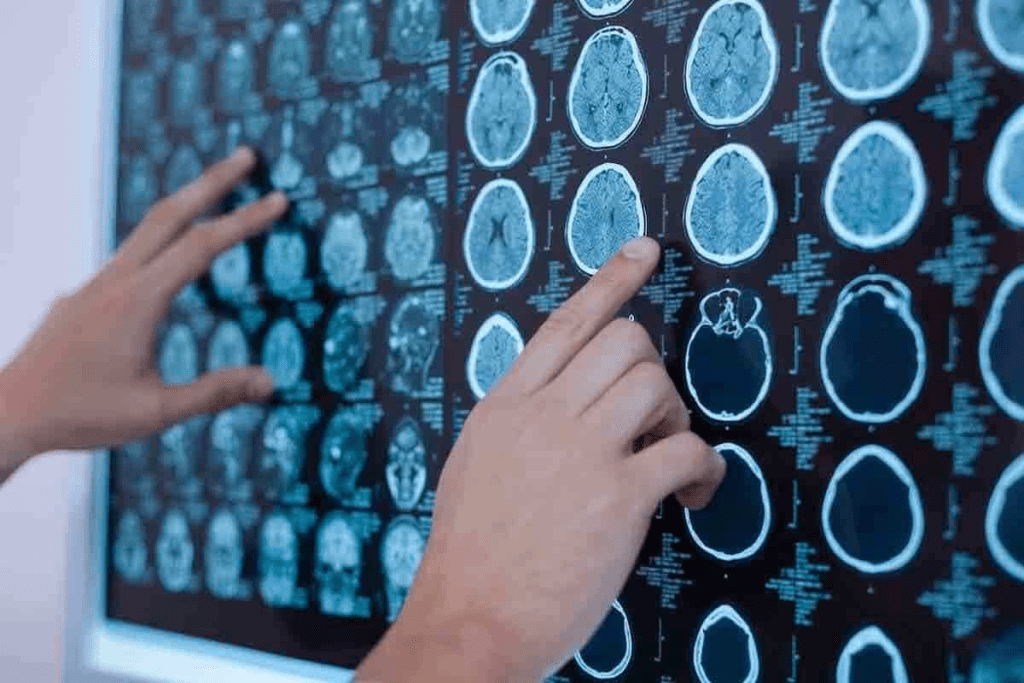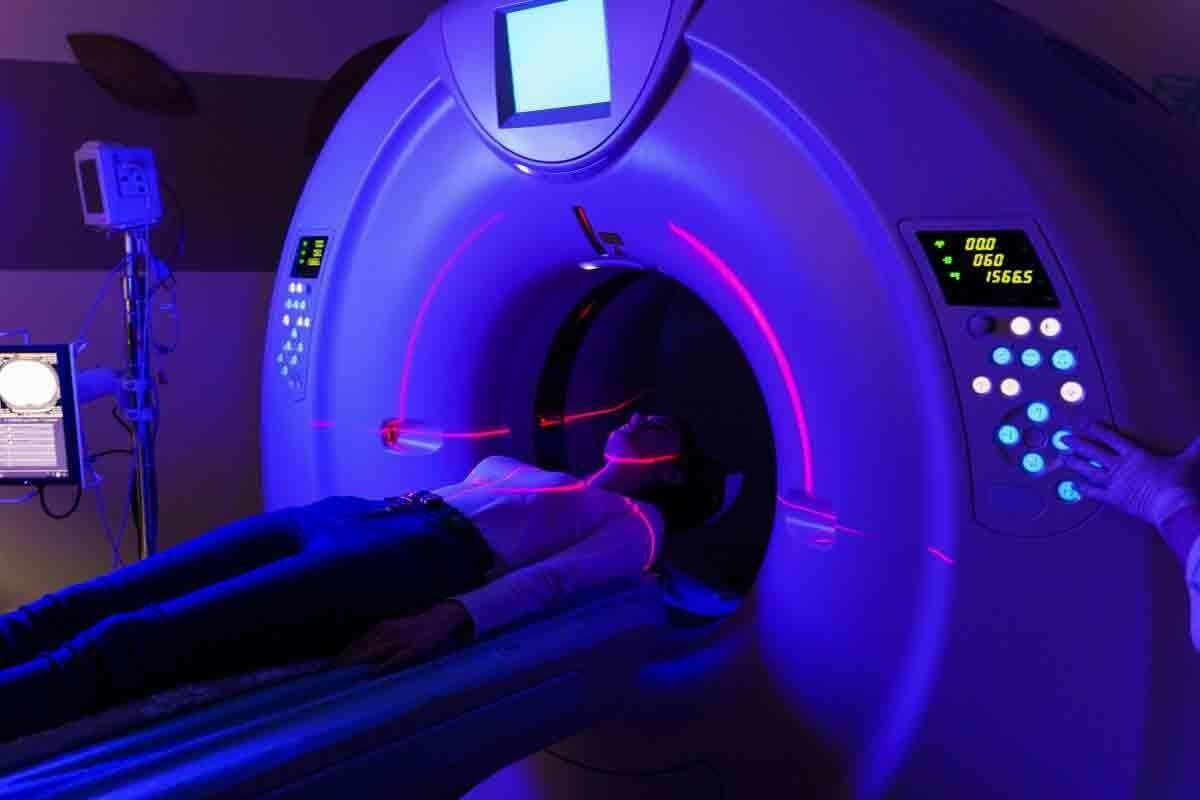Last Updated on November 27, 2025 by Bilal Hasdemir

Receiving a brain cancer diagnosis can be overwhelming, but with modern treatment options, there is hope for effective management and improved outcomes. Many patients wonder how to get rid of brain cancer, and at Liv Hospital, we provide answers through advanced therapies and personalized care. Our team combines cutting-edge expertise with deep compassion to guide patients through every step of their treatment journey.
Brain cancer encompasses a range of tumors originating in the brain, with glioblastoma multiforme (GBM) being the most aggressive and prevalent malignant form in adults. Modern strategies involve a combination of surgery, advanced radiotherapy, targeted chemotherapy, immunotherapy, and tumor-treating fields.
Key Takeaways
- Multidisciplinary approach is crucial in managing brain cancer
- Modern treatment options include surgery, radiotherapy, chemotherapy, and innovative therapies
- Effective management of brain cancer requires a combination of treatments
- Advanced radiotherapy and targeted chemotherapy improve treatment outcomes
- Immunotherapy and tumor-treating fields offer new hope for patients
Understanding Brain Cancer: Types, Stages, and Diagnosis

The journey to understanding brain cancer begins with recognizing its various types, identifying its stages, and comprehending the diagnostic procedures involved. Brain cancer, or brain tumors, can be benign or malignant, and their impact on the brain and the patient’s overall health varies significantly.
Common Types of Brain Tumors
Brain tumors are classified based on the type of cells they originate from. The most common types include:
- Gliomas: These tumors begin in the brain’s glial cells, which surround neurons. Gliomas can be low-grade (less aggressive) or high-grade (more aggressive).
- Meningiomas: These typically benign tumors form in the meninges, the layers of tissue covering the brain and spinal cord.
- Medulloblastomas: Most commonly found in children, these malignant tumors originate in the cerebellum or posterior fossa.
- Pituitary Adenomas: These usually benign tumors occur in the pituitary gland and can affect hormone production.
Understanding the specific type of brain tumor is crucial for determining the best treatment approach.
Warning Signs and Symptoms
The symptoms of brain cancer can vary widely depending on the tumor’s location, size, and type. Common symptoms include:
- Headaches that are persistent or worsening
- Seizures, especially in those without a history of seizure disorders
- Nausea or vomiting, particularly in the morning
- Vision problems, such as blurred vision, double vision, or loss of peripheral vision
- Difficulty with balance or walking
- Changes in personality or behavior
- Problems with speech or understanding language
Recognizing these symptoms early can lead to a timely diagnosis and potentially improve treatment outcomes.
Modern Diagnostic Procedures
Diagnosing brain cancer involves a combination of imaging tests and sometimes a biopsy. Modern diagnostic procedures include:
- Magnetic Resonance Imaging (MRI): Provides detailed images of the brain, helping to identify tumors and assess their size and location.
- Computed Tomography (CT) Scans: Useful for emergency situations, CT scans can quickly identify larger tumors or bleeding in the brain.
- Positron Emission Tomography (PET) Scans: Helps in assessing the tumor’s metabolic activity, which can be crucial for planning treatment.
- Biopsy: Involves taking a sample of the tumor tissue for pathological examination to determine its type and grade.
Accurate diagnosis is the cornerstone of effective brain cancer treatment. By understanding the type, stage, and characteristics of the tumor, healthcare providers can develop a personalized treatment plan that offers the best possible outcomes.
The Multidisciplinary Approach to Brain Tumor Management

Brain tumor management is most effective when it involves a coordinated effort from a diverse team of healthcare professionals. This multidisciplinary approach ensures that patients receive comprehensive care tailored to their specific needs.
Your Treatment Team: Key Specialists
A team of specialists works together to create an individualized management plan for brain tumor patients. The key specialists involved include:
- Neurosurgeons: Experts in surgical interventions for brain tumors.
- Oncologists: Specialists in cancer treatment, including chemotherapy and targeted therapy.
- Radiologists: Experts in imaging techniques and radiation therapy.
- Rehabilitation Specialists: Professionals who help patients recover and regain lost functions.
The role of each specialist is crucial in ensuring that all aspects of a patient’s care are addressed. For instance, neurosurgeons play a vital role in surgical interventions, while oncologists oversee the treatment plan, ensuring that it is comprehensive and tailored to the patient’s specific type of brain tumor.
Comprehensive Assessment Process
The comprehensive assessment process involves a series of evaluations to determine the best course of treatment. This includes:
| Assessment Type | Description |
| Imaging Studies | Utilizing MRI, CT scans, and PET scans to understand the tumor’s characteristics. |
| Biopsy | A procedure to obtain tissue samples for pathological examination. |
| Neurological Examination | Assessing the patient’s neurological status to identify any deficits. |
As
“The diagnosis and treatment of brain tumors require a multidisciplinary approach, involving neurosurgeons, neurologists, medical oncologists, radiation oncologists, and other healthcare professionals.”
, a statement that underscores the complexity and the collaborative nature of brain tumor management.
Treatment Centers and Second Opinions
Specialized treatment centers play a vital role in providing comprehensive care for brain tumor patients. These centers are equipped with state-of-the-art technology and staffed by experienced professionals. Seeking a second opinion from such centers can be invaluable, offering patients and their families additional insights and confidence in their treatment plan.
We recommend that patients explore options at reputable treatment centers and consider seeking second opinions to ensure they are receiving the most appropriate and effective care for their condition.
How to Get Rid of Brain Cancer: Surgical Interventions
Brain cancer surgery has evolved significantly, providing new hope for patients through advanced surgical techniques and improved post-operative care. Surgery remains a primary treatment modality for many types of brain tumors, aiming to remove as much of the tumor as possible while preserving neurological function.
Determining Surgical Candidacy
The decision to undergo surgery for brain cancer involves a comprehensive evaluation by a multidisciplinary team of specialists. Factors such as the tumor’s location, size, and type, as well as the patient’s overall health and neurological status, are carefully considered to determine if surgery is a viable option.
Key factors in determining surgical candidacy include:
- Tumor characteristics and location
- Patient’s overall health and performance status
- Presence of any comorbidities
- Potential risks and benefits of the surgical procedure
Advanced Surgical Techniques
Modern neurosurgery employs a range of advanced techniques to improve outcomes for brain cancer patients. These include:
- Intraoperative MRI and navigation: Enhancing precision during tumor resection
- Awake craniotomy: Allowing for real-time monitoring of neurological function during surgery
- Laser interstitial thermal therapy (LITT): A minimally invasive option for certain deep-seated or hard-to-reach tumors
These advanced techniques enable surgeons to achieve more complete tumor resections while minimizing damage to surrounding brain tissue.
Post-Surgical Recovery and Care
Effective post-surgical care is crucial for optimal recovery and outcomes in brain cancer patients. This includes:
- Close monitoring in a neurosurgical intensive care unit
- Management of potential post-operative complications
- Early initiation of rehabilitation services as needed
- Coordination of adjuvant therapies such as radiation and chemotherapy
By combining advanced surgical techniques with comprehensive post-operative care, we can significantly improve the prognosis and quality of life for many brain cancer patients.
Radiation Therapy: Precision Targeting of Tumor Cells
Precision in treating brain cancer is achieved through radiation therapy, which accurately targets tumor cells while sparing surrounding healthy tissue. We utilize radiation therapy as a critical component in brain cancer treatment, either post-surgery to eliminate remaining cancer cells or as a primary treatment when surgery is not feasible.
Conventional External Beam Radiation
Conventional external beam radiation therapy (EBRT) is a widely used method that delivers high-energy X-rays to the tumor site from outside the body. This technique allows us to target the tumor from multiple angles, maximizing the dose to the tumor while minimizing exposure to surrounding healthy brain tissue.
Stereotactic Radiosurgery (SRS)
Stereotactic radiosurgery (SRS) is a highly precise form of radiation therapy that delivers a large dose of radiation to a well-defined tumor in a single session. Despite being called “surgery,” SRS is non-invasive and doesn’t require an incision, making it an attractive option for tumors that are difficult to access surgically.
Proton Therapy for Sensitive Brain Regions
Proton therapy is an advanced form of radiation therapy that uses protons instead of X-rays to kill cancer cells. It’s particularly beneficial for tumors located near critical brain structures because it allows for more precise control over the radiation dose, reducing the risk of damage to sensitive areas.
Managing Radiation Side Effects
While radiation therapy is effective, it can cause side effects, including fatigue, hair loss, and swelling in the treated area. We work closely with patients to manage these side effects through medication, lifestyle adjustments, and follow-up care to ensure the best possible outcomes.
By understanding the different types of radiation therapy and their applications, we can tailor treatment plans to individual patient needs, maximizing effectiveness while minimizing side effects.
Chemotherapy Protocols for Brain Cancer Treatment
Chemotherapy remains a cornerstone in the treatment of brain cancer, offering various protocols tailored to individual patient needs. We use chemotherapy in combination with other treatments to target brain cancer cells effectively.
Standard Chemotherapy Agents
The choice of chemotherapy agents depends on the type of brain tumor, its grade, and the patient’s overall health. Commonly used agents include temozolomide, carmustine, and lomustine. These drugs work by interfering with the DNA of cancer cells, thereby inhibiting their ability to grow and divide.
For instance, temozolomide is often used in the treatment of glioblastoma, a aggressive form of brain cancer. It is administered orally and has been shown to improve survival rates when used in conjunction with radiation therapy.
Delivery Methods: Systemic vs. Local
Chemotherapy can be delivered systemically or locally. Systemic delivery involves administering chemotherapy drugs orally or intravenously, allowing them to reach cancer cells throughout the body. Local delivery, on the other hand, involves placing chemotherapy drugs directly into the tumor site or the cerebrospinal fluid.
Local delivery methods include intrathecal chemotherapy, where drugs are administered directly into the spinal fluid, and convection-enhanced delivery, which involves using a catheter to deliver drugs directly to the tumor site.
| Delivery Method | Description | Advantages |
| Systemic | Oral or intravenous administration | Targets cancer cells throughout the body |
| Local | Direct delivery to tumor site or cerebrospinal fluid | Higher drug concentration at tumor site, reduced systemic side effects |
Blood-Brain Barrier Considerations
The blood-brain barrier (BBB) is a significant obstacle in brain cancer treatment, as it prevents many chemotherapy drugs from reaching the tumor site in effective concentrations. We are exploring various strategies to overcome this challenge, including the use of drugs that can cross the BBB and techniques to temporarily disrupt the BBB.
Monitoring and Managing Side Effects
Chemotherapy can cause a range of side effects, from mild to severe. Common side effects include nausea, fatigue, hair loss, and increased risk of infections. We closely monitor patients undergoing chemotherapy and implement strategies to manage these side effects effectively.
For example, anti-nausea medications can be prescribed to manage chemotherapy-induced nausea. Additionally, patients are advised on how to maintain a healthy lifestyle, including a balanced diet and regular exercise, to mitigate some of the side effects.
Brain Tumor Treatment Without Surgery: Non-Invasive Options
When surgery isn’t possible, innovative non-invasive treatments can be a viable option for managing brain tumors. Advances in medical technology have expanded the range of alternatives available to patients, offering new hope and improved outcomes.
Alternative Approaches When Surgery Isn’t Possible
For patients with brain tumors that cannot be surgically removed, other treatment modalities come into play. These alternatives are crucial for managing the condition and improving the patient’s quality of life. Non-surgical treatments are often used in conjunction with other therapies to achieve the best possible outcome.
Tumor Treating Fields (TTF) Therapy
Tumor Treating Fields (TTF) therapy is a non-invasive treatment that uses electric fields to disrupt the division of tumor cells. This therapy is particularly useful for certain types of brain tumors, such as glioblastoma. By wearing a device that delivers these electric fields, patients can continue with their daily activities while undergoing treatment.
TTF therapy has been shown to be effective in slowing down tumor growth and improving survival rates in some patients. It’s a treatment option that is generally well-tolerated, with minimal side effects compared to traditional chemotherapy or radiation therapy.
Laser Interstitial Thermal Therapy (LITT)
Laser Interstitial Thermal Therapy (LITT) is a minimally invasive procedure that uses laser heat to destroy tumor cells. Although it involves a small incision, LITT is considered non-invasive in the context of not requiring open surgery. It’s used for treating tumors that are difficult to access or in sensitive areas of the brain.
LITT offers the advantage of precise targeting of tumor cells while minimizing damage to surrounding healthy tissue. This precision can lead to fewer complications and a quicker recovery time for patients.
Focused Ultrasound Treatment
Focused ultrasound treatment is another non-invasive option that uses high-frequency sound waves to target and destroy tumor cells. This treatment is guided by MRI to ensure precise targeting. It’s a promising technology that is still being studied for its efficacy in treating brain tumors.
The potential benefits of focused ultrasound include its non-invasive nature, reducing the risk of infection and other complications associated with surgical procedures. As research continues, this treatment may become a more widely available option for patients with brain tumors.
How to Shrink Brain Tumors: Targeted and Biological Therapies
Targeted and biological therapies have revolutionized the treatment of brain tumors, offering new hope for patients. These innovative approaches focus on specific molecules or biological processes involved in tumor growth, providing more precise and potentially more effective treatments.
Molecular Targeted Therapies
Molecular targeted therapies are designed to target specific genetic mutations or proteins that drive the growth of brain tumors. By inhibiting these targets, these therapies aim to slow or stop tumor growth while minimizing damage to healthy cells. For example, drugs targeting the BRAF V600E mutation have shown promise in treating certain types of brain tumors.
We are seeing significant advancements in the development of targeted therapies, with ongoing research identifying new molecular targets and improving our understanding of tumor biology.
Anti-Angiogenic Treatments
Anti-angiogenic treatments work by inhibiting the formation of new blood vessels that tumors need to grow. By cutting off the tumor’s supply of nutrients and oxygen, these treatments can help shrink tumors or slow their growth. Bevacizumab is an example of an anti-angiogenic drug that has been used in the treatment of certain brain cancers.
While anti-angiogenic treatments can be effective, we are continually working to improve our understanding of how to best combine these therapies with other treatments for maximum benefit.
Gene Therapy Approaches
Gene therapy approaches involve introducing genetic material into cells to prevent or treat diseases. In the context of brain tumors, gene therapy can be used to deliver genes that promote cancer cell death or enhance the body’s immune response against the tumor. Various gene therapy strategies are being explored, including those that aim to repair or replace faulty genes in cancer cells.
As research progresses, we are optimistic about the potential for gene therapy to become a valuable addition to our treatment arsenal against brain tumors.
Monitoring Tumor Response
Monitoring how brain tumors respond to targeted and biological therapies is crucial for assessing treatment effectiveness and making necessary adjustments. Advanced imaging techniques, such as MRI and PET scans, play a vital role in this process. These tools allow us to track changes in tumor size and activity over time.
Regular assessments enable us to tailor treatment plans to individual patient needs, optimizing care and improving outcomes.
Advanced Brain Cancer Treatment: Immunotherapy Approaches
Immunotherapy represents a revolutionary step in treating brain cancer, focusing on enhancing the body’s natural defenses. This approach has shown significant promise in advanced brain cancer treatment, offering new avenues for patients who may have limited options.
Checkpoint Inhibitors
Checkpoint inhibitors are a class of immunotherapy drugs that release the brakes on the immune system, allowing it to attack cancer cells more effectively. These drugs target specific proteins on immune cells or cancer cells, preventing them from interacting in a way that suppresses the immune response.
Examples of checkpoint inhibitors include:
- PD-1 inhibitors (e.g., pembrolizumab)
- CTLA-4 inhibitors (e.g., ipilimumab)
CAR T-Cell Therapy
CAR T-cell therapy is a form of immunotherapy that involves removing T cells from a patient’s blood, modifying them to recognize cancer cells, and then reinfusing them. This approach has shown potential in treating certain types of brain cancer.
The process involves several steps:
- T cells are extracted from the patient’s blood.
- These T cells are genetically modified to produce chimeric antigen receptors (CARs) that target specific proteins on cancer cells.
- The modified T cells are expanded in number.
- The CAR T cells are infused back into the patient.
Vaccine-Based Treatments
Vaccine-based treatments aim to stimulate the immune system to recognize and attack cancer cells. These vaccines can be made from the patient’s own tumor cells or from specific proteins associated with brain cancer.
| Vaccine Type | Description | Potential Benefits |
| Autologous Tumor Cell Vaccines | Made from the patient’s own tumor cells | Personalized treatment approach |
| Peptide-Based Vaccines | Target specific proteins on cancer cells | Can be designed to target multiple antigens |
Combination Immunotherapy Strategies
Combining different immunotherapy approaches is being explored to enhance treatment efficacy. This can include combining checkpoint inhibitors with other forms of immunotherapy, such as CAR T-cell therapy or vaccine-based treatments.
As research continues to advance, the potential for immunotherapy to improve outcomes in advanced brain cancer treatment grows. We are committed to staying at the forefront of these developments to offer the most effective and innovative treatment options to our patients.
Personalized Brain Cancer Therapies
As we continue to advance in our understanding of brain cancer, personalized therapies are becoming increasingly crucial. The one-size-fits-all approach is giving way to treatments tailored to the unique molecular characteristics of each patient’s tumor.
Biomarker Testing and Genetic Profiling
Biomarker testing and genetic profiling are at the forefront of personalized brain cancer treatment. By analyzing the genetic makeup of a tumor, healthcare providers can identify specific biomarkers that may influence treatment decisions. This approach allows for more targeted and potentially more effective therapies.
“The integration of biomarker testing into clinical practice has revolutionized the way we treat brain cancer patients,” says Dr. Jane Smith, a leading neuro-oncologist. “It’s not just about treating the tumor; it’s about understanding the tumor’s unique characteristics and tailoring our approach accordingly.”
Tailoring Treatment to Molecular Characteristics
Once the molecular characteristics of a brain tumor are identified, treatment can be tailored to target specific vulnerabilities. This may involve selecting from a range of therapies, including targeted drugs, immunotherapies, or other innovative treatments.
- Targeted therapies that exploit specific genetic mutations
- Immunotherapies that boost the body’s natural defenses against cancer
- Precision medicine approaches that combine multiple modalities for optimal effect
Emerging Precision Medicine Approaches
The field of precision medicine is rapidly evolving, with new approaches being developed to treat brain cancer more effectively. Some of the emerging strategies include:
- Liquid biopsies that allow for real-time monitoring of tumor genetics
- Artificial intelligence-driven analysis of tumor data to predict treatment response
- Nanotechnology-based delivery systems for more precise drug targeting
Clinical Trials and Experimental Treatments
Clinical trials play a crucial role in the development of new and innovative treatments for brain cancer. By participating in clinical trials, patients can gain access to cutting-edge therapies that may not be available through standard treatment options.
It’s an exciting time for brain cancer research, with numerous promising therapies in the pipeline. As we continue to push the boundaries of what’s possible, we remain committed to providing our patients with the most advanced and personalized care available.
Conclusion: Living with and Beyond Brain Cancer
As we have explored throughout this guide, managing brain cancer requires a comprehensive and multidisciplinary approach. Advances in treatment options, including surgical interventions, radiation therapy, chemotherapy, and immunotherapy, have significantly improved brain cancer treatment outcomes. By understanding the various treatments available, patients can better navigate their care and make informed decisions about their health.
Living with brain cancer presents unique challenges, but with the right support and care, many patients are able to manage their condition effectively. Palliative care plays a crucial role in improving quality of life, and ongoing research continues to uncover new and innovative treatment strategies. As we move forward, the focus remains on enhancing brain cancer survival rates and supporting patients throughout their journey.
Ultimately, the goal is to provide patients with the tools and resources needed to thrive beyond their diagnosis. By combining cutting-edge medical treatments with comprehensive support services, we can improve outcomes and enhance the overall well-being of those affected by brain cancer.
FAQ
What are the common symptoms of brain cancer?
Common symptoms of brain cancer include headaches, seizures, confusion, difficulty with speech or vision, and changes in personality or behavior. The specific symptoms can vary depending on the tumor’s location and size.
How is brain cancer diagnosed?
Brain cancer is diagnosed through a combination of imaging tests such as MRI or CT scans, and a biopsy to examine the tumor tissue. Accurate diagnosis is crucial in determining the appropriate treatment plan.
What is the role of surgery in treating brain cancer?
Surgery is often the first line of treatment for brain cancer, aiming to remove as much of the tumor as possible while preserving surrounding brain function. The decision to undergo surgery depends on the tumor’s location, size, and type.
What are the different types of radiation therapy used in brain cancer treatment?
Radiation therapy for brain cancer includes conventional external beam radiation, stereotactic radiosurgery (SRS), and proton therapy. Each type targets tumor cells with precision, minimizing damage to surrounding brain tissue.
How does chemotherapy work in treating brain cancer?
Chemotherapy uses drugs to kill cancer cells or stop them from growing. For brain cancer, chemotherapy can be administered systemically or locally, and the choice of agents depends on the tumor type and other factors.
What are Tumor Treating Fields (TTF) therapy and how does it work?
TTF therapy is a non-invasive treatment that uses electrical fields to disrupt cancer cell division, slowing tumor growth. It’s used for certain types of brain cancer, particularly glioblastoma.
Can immunotherapy be used to treat brain cancer?
Yes, immunotherapy is being increasingly used in advanced brain cancer treatment. Approaches include checkpoint inhibitors, CAR T-cell therapy, and vaccine-based treatments, which work by enhancing the body’s immune response against cancer cells.
What is personalized medicine in the context of brain cancer?
Personalized medicine involves tailoring treatment to the individual characteristics of the patient’s tumor, often through biomarker testing and genetic profiling. This approach allows for more targeted and effective treatment strategies.
Are there any new or experimental treatments for brain cancer?
Yes, there are ongoing clinical trials and emerging treatments for brain cancer, including new targeted therapies, immunotherapies, and precision medicine approaches. These offer hope for improved outcomes and are often available through clinical trials.
How can patients access the latest treatments and clinical trials for brain cancer?
Patients can access the latest treatments and clinical trials by consulting with their healthcare team, seeking a second opinion at a specialized treatment center, or searching for clinical trials on reputable databases.
What is the importance of a multidisciplinary team in brain cancer treatment?
A multidisciplinary team, including neurosurgeons, oncologists, radiologists, and other specialists, works together to provide comprehensive care, ensuring that all aspects of the patient’s condition are considered in developing a treatment plan.
How can brain cancer patients manage treatment side effects?
Managing treatment side effects involves a combination of medication, lifestyle adjustments, and supportive care. Patients should work closely with their healthcare team to monitor and mitigate side effects.
What is the role of treatment centers and second opinions in brain cancer care?
Specialized treatment centers and second opinions play a crucial role in ensuring that patients receive the most appropriate and up-to-date treatment for their specific condition, potentially improving outcomes.
Can brain tumors be shrunk without surgery?
Yes, brain tumors can be shrunk without surgery through treatments such as radiation therapy, chemotherapy, targeted therapies, and immunotherapy. The choice of treatment depends on the tumor type, size, and location.
What is the prognosis for living with and beyond brain cancer?
The prognosis varies widely depending on the type, stage, and location of the brain cancer, as well as the patient’s overall health and response to treatment. Advances in treatment and supportive care have improved outcomes for many patients.
References
- Weller, M., van den Bent, M., Tonn, J. C., Stupp, R., Preusser, M., Cohen-Jonathan-Moyal, E., … & Reifenberger, G. (2017). European Association for Neuro-Oncology (EANO) guideline on the diagnosis and treatment of adult astrocytic and oligodendroglial gliomas. The Lancet Oncology, 18(6), e315-e326.https://www.sciencedirect.com/science/article/pii/S1470204517301948






